light FORD FIESTA 2007 Service Manual
[x] Cancel search | Manufacturer: FORD, Model Year: 2007, Model line: FIESTA, Model: FORD FIESTA 2007Pages: 1226, PDF Size: 61.26 MB
Page 618 of 1226
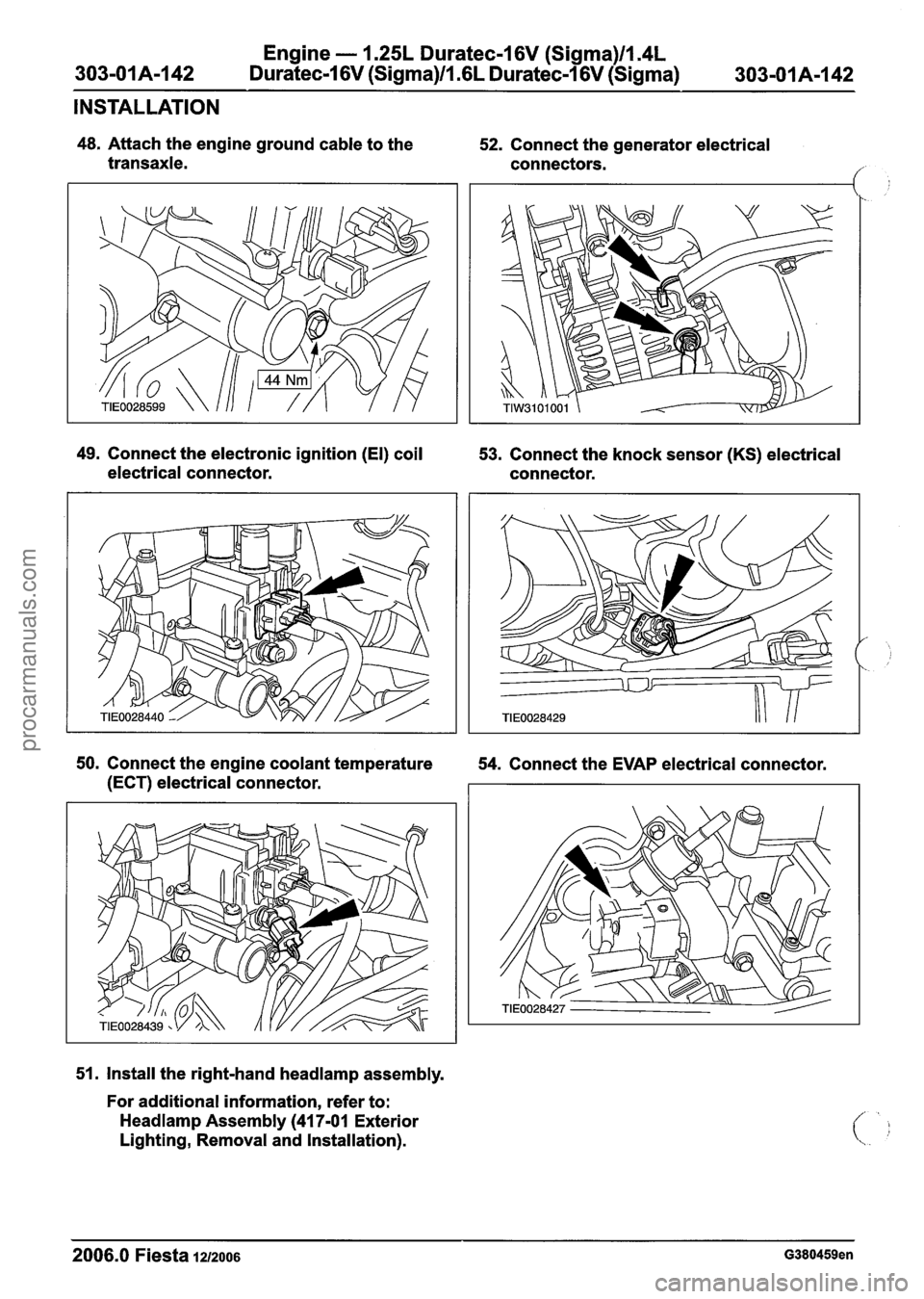
Engine - 1.25L Duratec-1 6V (Sigma)ll.4L
303-01A-I42 Duratec-1 6V (Sigma)/l .6L Duratec-I 6V (Sigma)
INSTALLATION
48. Attach the engine ground cable to the
transaxle. 52.
Connect the generator electrical
connectors.
49. Connect the electronic ignition (El) coil
53. Connect the knock sensor
(KS) electrical
electrical connector. connector.
50. Connect the engine coolant temperature
54. Connect the EVAP electrical connector.
(ECT) electrical connector.
51. Install the right-hand
headlamp assembly.
For additional information, refer to:
Headlamp Assembly (41 7-01 Exterior
Lighting, Removal and Installation).
2006.0 Fiesta 1212006 G380459en
procarmanuals.com
Page 631 of 1226
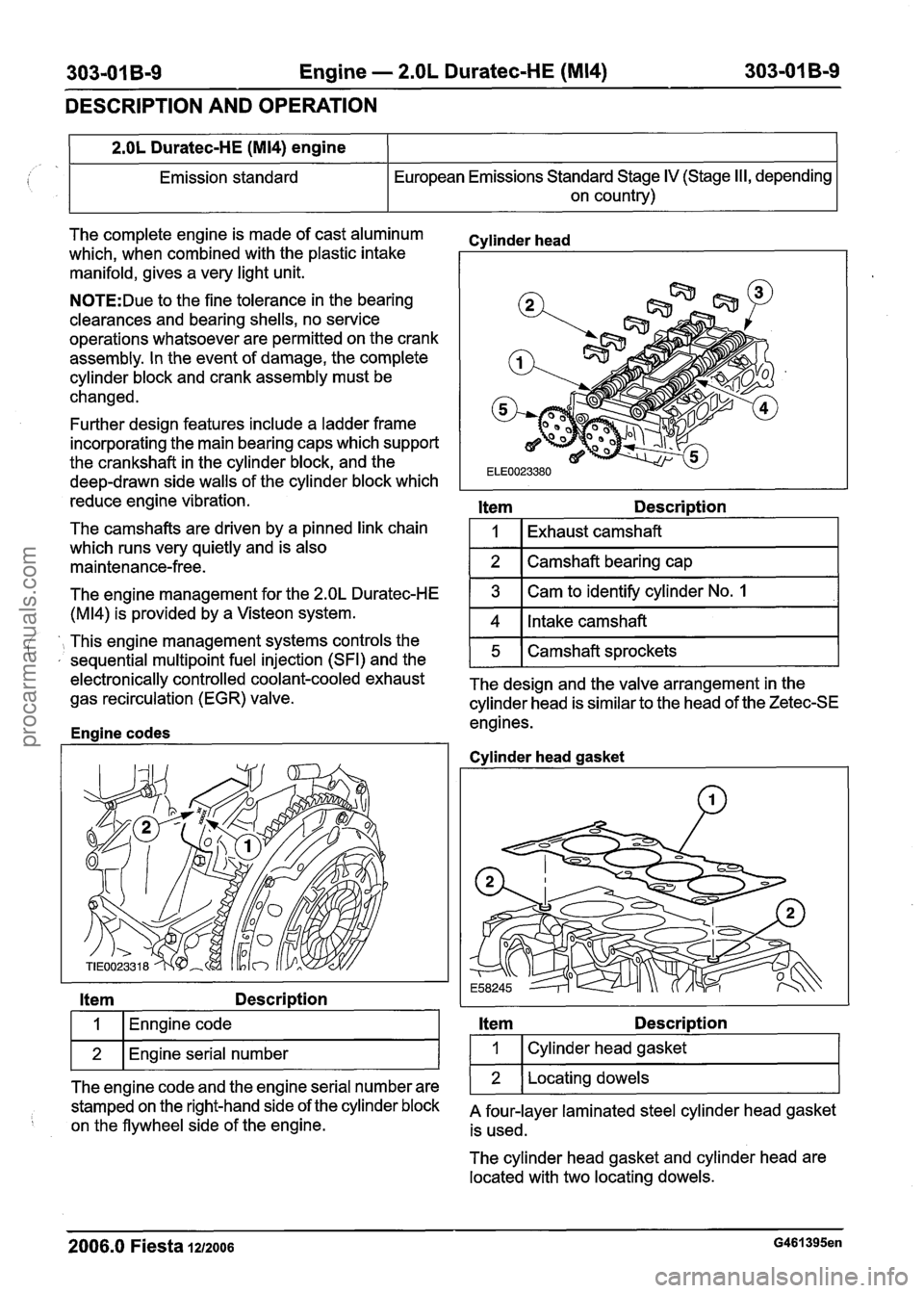
303101 B-9 Engine - 2.OL Duratec-HE (M14) 303-01 B-9
DESCRIPTION AND OPERATION
The complete engine is made of cast aluminum
which, when combined with the plastic intake
manifold, gives a very light unit.
2.OL Duratec-HE (M14) engine
Emission standard
N0TE:Due to the fine tolerance in the bearing
clearances and bearing shells, no service
operations whatsoever are permitted on the crank
assembly. In the event of damage, the complete
cylinder block and crank assembly must be
changed. European
Emissions Standard Stage
IV (Stage II I, depending
on country)
Further design features include a ladder frame
incorporating the main bearing caps which support
the crankshaft in the cylinder block, and the
deep-drawn side walls of the cylinder block which
reduce engine vibration.
The camshafts are driven by a pinned link chain
which runs very quietly and is also
maintenance-free.
Cvlinder head
Item Description
1
2
The engine management for the 2.OL Duratec-HE
(M14) is provided by a Visteon system.
Item Description
Exhaust camshaft
Camshaft bearing cap
', This engine management systems controls the ' , sequential multipoint fuel injection (SFI) and the
I 1 (Enngine code I
3
4
wl~n~ine serial number I
Cam to identify cylinder No. 1
Intake camshaft
ele~tronically controlled coolant-cooled exhaust The design and the valve arrangement in the gas recirculation (EGR) valve.
cylinder head is similar to the head of the Zetec-SE
engines.
Enaine codes
5
The engine code and the engine serial number are
stamped on the right-hand side of the cylinder block
on the flywheel side of the engine. Camshaft sprockets
Cvlinder
head gasket
Item Description
I 1 I Cylinder head gasket I
1 2 1 Locating dowels 1
A four-layer laminated steel cylinder head gasket
is used.
The cylinder head gasket and cylinder head are
located with two locating dowels.
2006.0 Fiesta 1212006 G461395en
procarmanuals.com
Page 643 of 1226
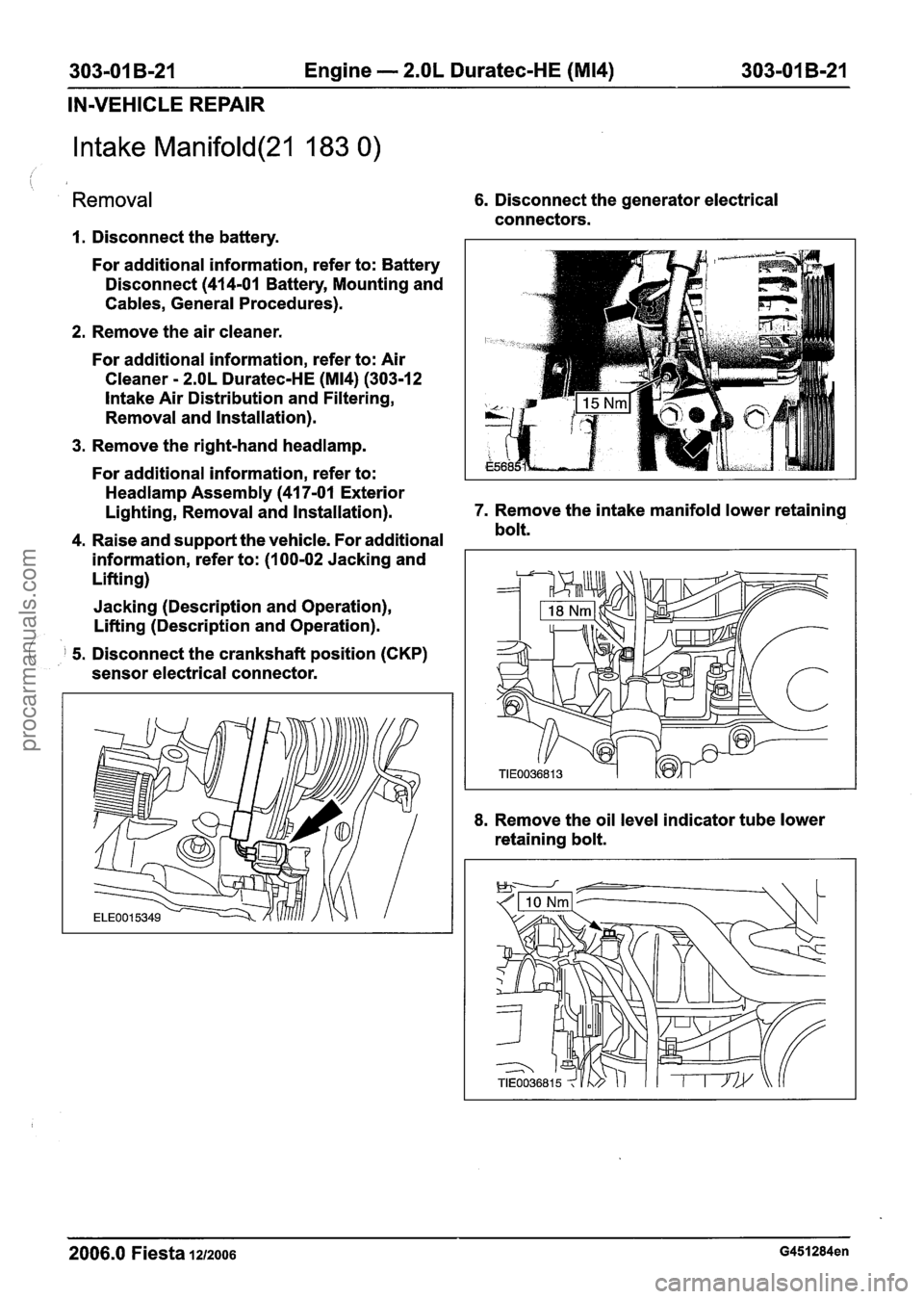
303-01 B-21 Engine - 2.OL Duratec-HE (M14) 303-01 B-21
IN-VEHICLE REPAIR
Intake Manifold(21 183 0)
Removal
1. Disconnect the battery.
For additional information, refer to: Battery
Disconnect (414-01 Battery, Mounting and
Cables, General Procedures).
2. Remove the air cleaner.
For additional information, refer to: Air
Cleaner
- 2.OL Duratec-HE (M14) (303-12
lntake Air Distribution and Filtering,
Removal and Installation).
3. Remove the right-hand headlamp.
6. Disconnect the generator electrical
connectors.
For additional information, refer to:
Headlamp Assembly (41 7-01 Exterior
Lighting, Removal and Installation). 7.
Remove the intake manifold lower retaining
4. Raise and support the vehicle. For additional bolt.
information, refer to: (I
00-02 Jacking and
Lifting)
Jacking (Description and Operation),
Lifting (Description and Operation).
( 5. Disconnect the crankshaft position (CKP)
sensor electrical connector.
8. Remove the oil level indicator tube lower
retaining bolt.
2006.0 Fiesta 1212006 G451284en
procarmanuals.com
Page 691 of 1226
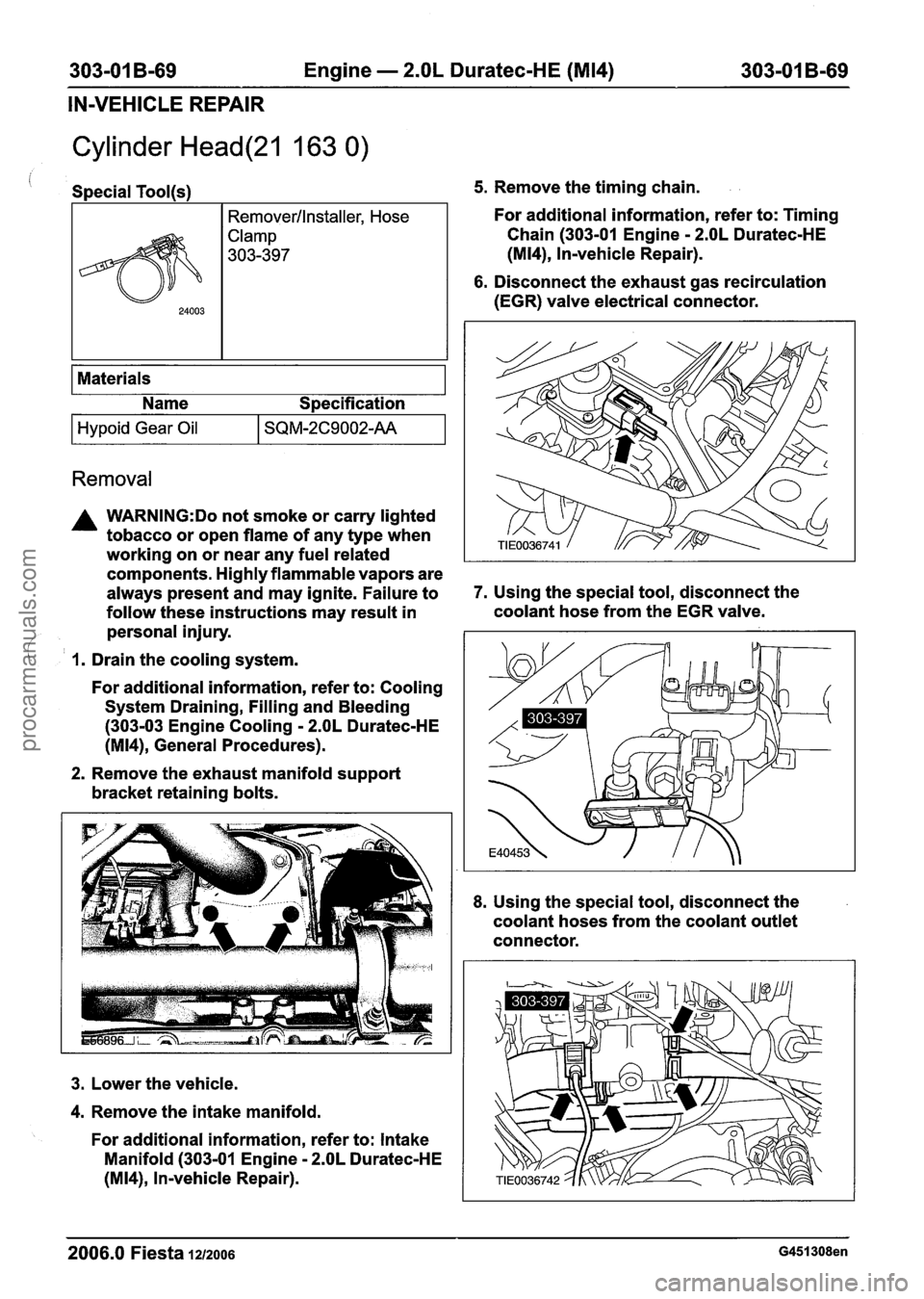
303-01 B-69 Engine - 2.OL Duratec-HE (M14) 303-01 B-69
IN-VEHICLE REPAIR
Cylinder Head(21 163 0)
Special Tool(s) 5. Remove the timing chain.
I Materials I
24003
I I Name Specification
Remover/lnstaller, Hose
Clamp
303-397
Removal
For additional information, refer to: Timing
Chain (303-01 Engine
- 2.OL Duratec-HE
(M14), Invehicle Repair).
6. Disconnect the exhaust gas recirculation
(EGR) valve electrical connector.
Hypoid Gear Oil
A WARNING:Do not smoke or carry lighted
tobacco or open flame of any type when
working on or near any fuel related
components. Highly flammable vapors are
always present and may ignite. Failure to
7. Using the special tool, disconnect the
follow these instructions may result in coolant hose
from the EGR valve.
personal injury.
/
SQM-2C9002-AA
( I. Drain the cooling system.
For additional information, refer to: Cooling
System Draining, Filling and Bleeding
(303-03 Engine Cooling
- 2.OL Duratec-HE
(M14), General Procedures).
2. Remove the exhaust manifold support
bracket retaining bolts.
3. Lower the vehicle.
4. Remove the intake manifold.
For additional information, refer to: Intake
Manifold (303-01 Engine
- 2.OL Duratec-HE
(M14), In-vehicle Repair).
8. Using the special tool, disconnect the
coolant hoses from the coolant outlet
connector.
2006.0 Fiesta 1212006 G451308en
procarmanuals.com
Page 696 of 1226
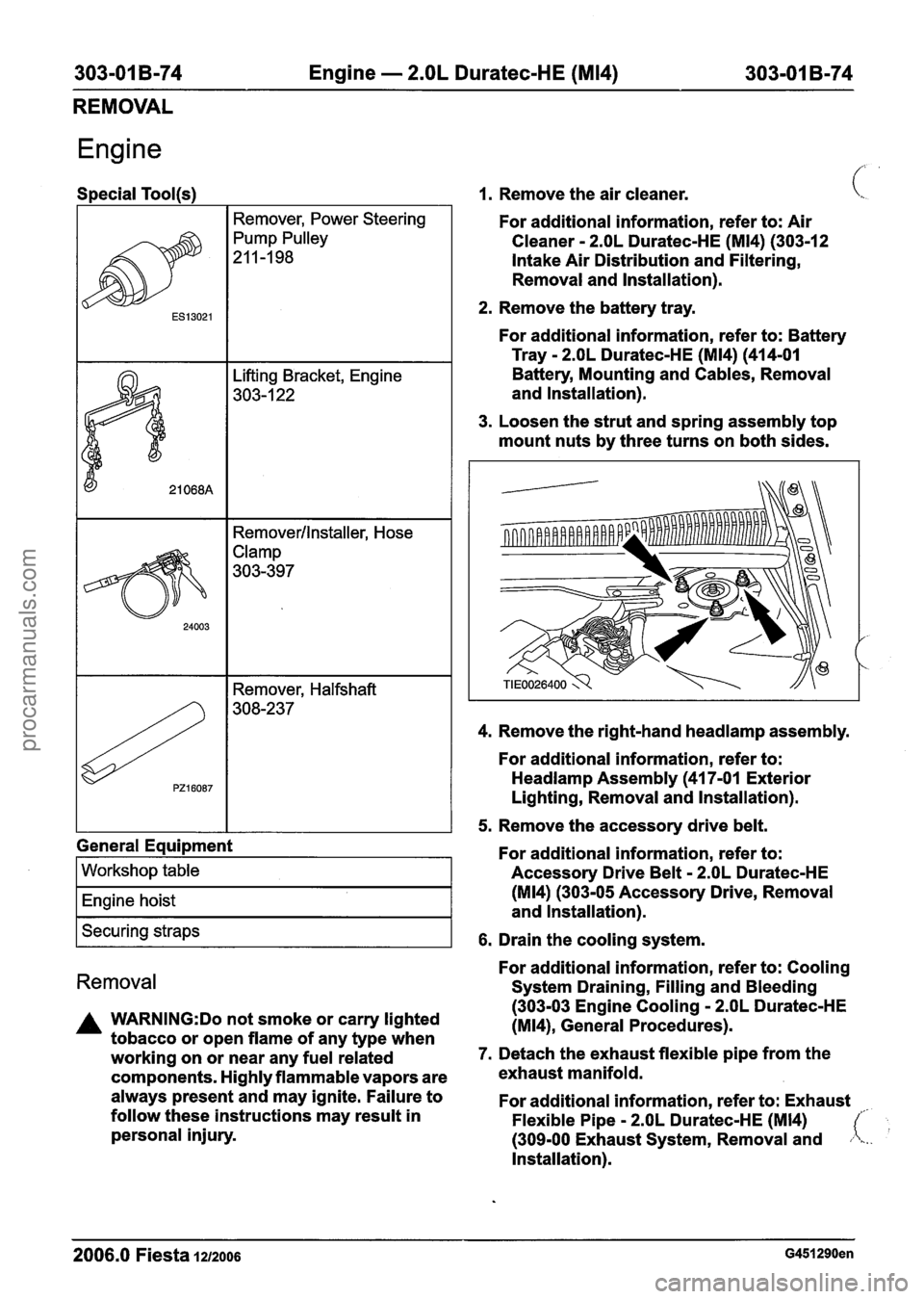
303-01 B-74 Engine - 2.OL Duratec-HE (M14) 303-01 B-74
REMOVAL
Engine
Special Tool(s)
I I Remover, Power Steering I
I I Removerllnstaller, Hose
General Equipment
I Workshop table I
I Engine hoist I
I Securing straps I
Removal
A WARNING:Do not smoke or carry lighted
tobacco or open flame of any type when
working on or near any fuel related
components. Highly flammable vapors are
always present and may ignite. Failure to
follow these instructions may result in
personal injury.
1. Remove the air cleaner. c.
For additional information, refer to: Air
Cleaner
- 2.OL Duratec-HE (M14) (30312
Intake Air Distribution and Filtering,
Removal and Installation).
2. Remove the battery tray.
For additional information, refer to: Battery
Tray
- 2.OL Duratec-HE (M14) (414-01
Battery, Mounting and Cables, Removal
and Installation).
3. Loosen the strut and spring assembly top
mount nuts by three turns on both sides.
4. Remove the right-hand
headlamp assembly.
For additional information, refer to:
Headlamp Assembly (41 7-01 Exterior
Lighting, Removal and Installation).
5. Remove the accessory drive belt.
For additional information, refer to:
Accessory Drive Belt
- 2.OL Duratec-HE
(M14) (303-05 Accessory Drive, Removal
and Installation).
6. Drain the cooling system.
For additional information, refer to: Cooling
System Draining, Filling and Bleeding
(303-03 Engine Cooling
- 2.OL Duratec-HE
(M14), General Procedures).
7. Detach the exhaust flexible pipe from the
exhaust manifold.
For additional information, refer to: Exhaust
Flexible Pipe
- 2.OL Duratec-HE (M14)
(309-00 Exhaust System, Removal and
Installation).
2006.0 Fiesta 1212006 G451290en
procarmanuals.com
Page 733 of 1226

303-01 B-I11 Engine - 2.OL Duratec-HE (M14) 303-01 B-111
INSTALLATION
Engine
i Special Tool(s)
I
I Remover/lnstaller, Hose
General Equipment
I Workshop table 1
I Securing straps I
I Engine hoist I --
A WARNING:Do not smoke or carry lighted
tobacco or open flame of any type when
working on or near any fuel related
components. Highly flammable vapors are
always present and may ignite. Failure to
follow these instructions may result in
personal injury.
1. N0TE:Using suitable retaining straps, secure
the engine on the workshop table.
Support the engine with wooden blocks.
2. Install the transaxle.
3. Install the transaxle upper retaining bolts.
4. Install the transaxle left-hand retaining bolts.
5. Install the transaxle right-hand retaining
bolts.
2006.0 Fiesta 1212006 ~451291 en
procarmanuals.com
Page 741 of 1226
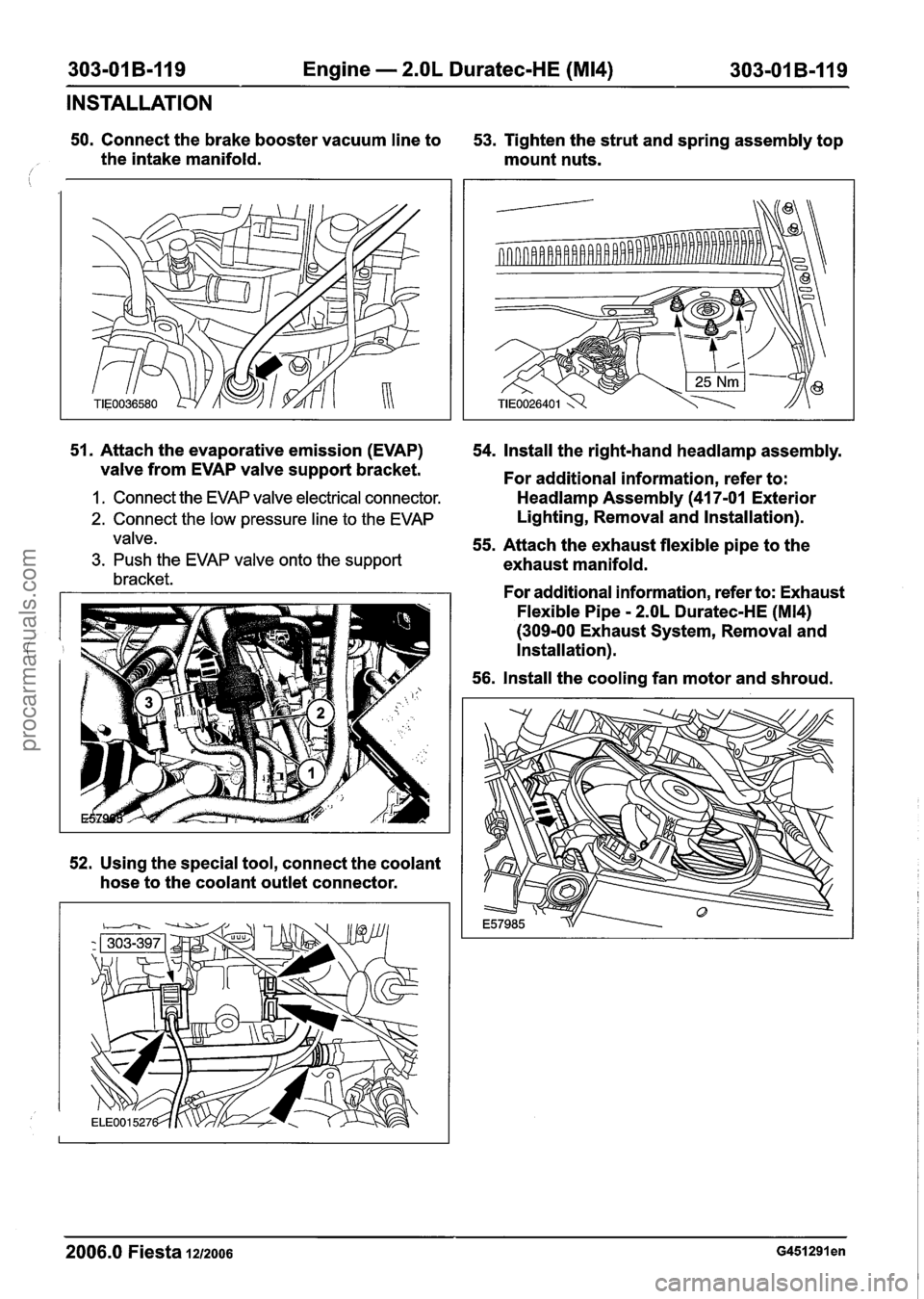
303-01 B-1/19 Engine - 2.OL Duratec-HE (M14) 303-01 B-119
INSTALLATION
50. Connect the brake booster vacuum line to
53. Tighten the strut and spring assembly top
the intake manifold. mount nuts.
/
51. Attach the evaporative emission (EVAP)
valve from EVAP valve support bracket.
I. Connect the EVAP valve electrical connector.
2. Connect the low pressure line to the EVAP
valve.
3. Push the EVAP valve onto the support
bracket.
52. Using the special tool, connect the coolant
hose to the coolant outlet connector. 54.
Install the right-hand
headlamp assembly.
For additional information, refer to:
Headlamp Assembly (41 7-01 Exterior
Lighting, Removal and Installation).
55. Attach the exhaust flexible pipe to the
exhaust manifold.
For additional information, refer to: Exhaust
Flexible Pipe
- 2.OL Duratec-HE (M14)
(309-00 Exhaust System, Removal and
Installation).
56. Install the cooling fan motor and shroud.
2006.0 Fiesta 1212006 ~451291 en
procarmanuals.com
Page 759 of 1226
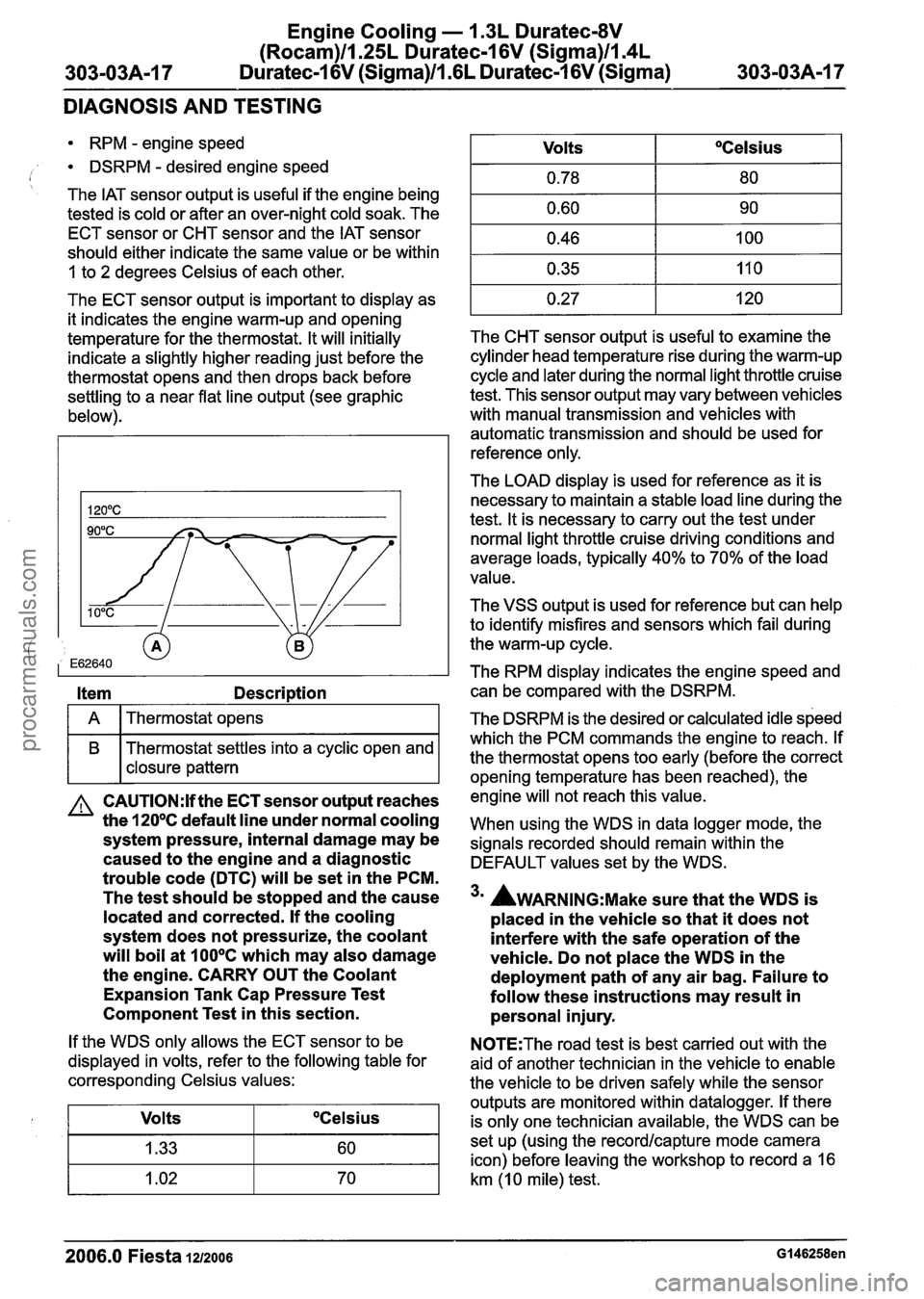
Engine Cooling - I .3L Duratec-8V
(Rocam)llm25L Duratec-1 6V (Sigma)ll.4L
303-03A-17 Duratec-1 6V (Sigma)/lm6L Duratec-1 6V (Sigma) 303-03A-17
DIAGNOSIS AND TESTING
RPM - engine speed
i DSRPM - desired engine speed
The IAT sensor output is useful if the engine being
tested is cold or after an over-night cold soak. The
ECT sensor or CHT sensor and the IAT sensor
should either indicate the same value or be within
1 to 2 degrees Celsius of each other.
The ECT sensor output is important to display as
it indicates the engine warm-up and opening
temperature for the thermostat. It will initially
indicate a slightly higher reading just before the
thermostat opens and then drops back before
settling to a near flat line output (see graphic
below).
Item Description
I A I Thermostat opens I
B Thermostat settles into a cyclic open and
I I closure pattern
A CAUTI0N:lf the ECT sensor output reaches
the
120°C default line under normal cooling
system pressure, internal damage may be
caused to the engine and a diagnostic
trouble code (DTC) will be set in the PCM.
The test should be stopped and the cause
located and corrected. If the cooling
system does not pressurize, the coolant
will boil at
100°C which may also damage
the engine. CARRY OUT the Coolant
Expansion Tank Cap Pressure Test
Component Test in this section.
If the WDS only allows the ECT sensor to be
displayed in volts, refer to the following table for
corresponding Celsius values:
Volts
OCelsius
The CHT sensor output is useful to examine the
cylinder head temperature rise during the warm-up
cycle and later during the normal light throttle cruise
test. This sensor output may vary between vehicles
with manual transmission and vehicles with
automatic transmission and should be used for
reference only.
Volts
0.78
0.60
0.46
0.35
0.27
The
LOAD display is used for reference as it is
necessary to maintain a stable load line during the
test. It is necessary to carry out the test under
normal light throttle cruise driving conditions and
average loads, typically
40% to 70% of the load
value.
OCelsius
80
90
100
11 0
120
The VSS output is used for reference but can help
to identify misfires and sensors which fail during
the warm-up cycle.
The RPM display indicates the engine speed and can be compared with the DSRPM.
The DSRPM is the desired or calculated idle speed
which the PCM commands the engine to reach. If
the thermostat opens too early (before the correct
opening temperature has been reached), the
engine will not reach this value.
When using the WDS in data logger mode, the
signals recorded should remain within the
DEFAULT values set by the WDS.
3m AWARNING:M~~~ sure that the WDS is
placed in the vehicle so that it does not
interfere with the safe operation of the
vehicle. Do not place the WDS in the
deployment path of any air bag. Failure to
follow these instructions may result in personal injury.
N0TE:The road test is best carried out with the
aid of another technician in the vehicle to enable
the vehicle to be driven safely while the sensor
outputs are monitored within datalogger. If there
is only one technician available, the WDS can be
set up (using the
recordlcapture mode camera
icon) before leaving the workshop to record a
16
km (1 0 mile) test.
2006.0 Fiesta 1212006 GI 46258en
procarmanuals.com
Page 760 of 1226
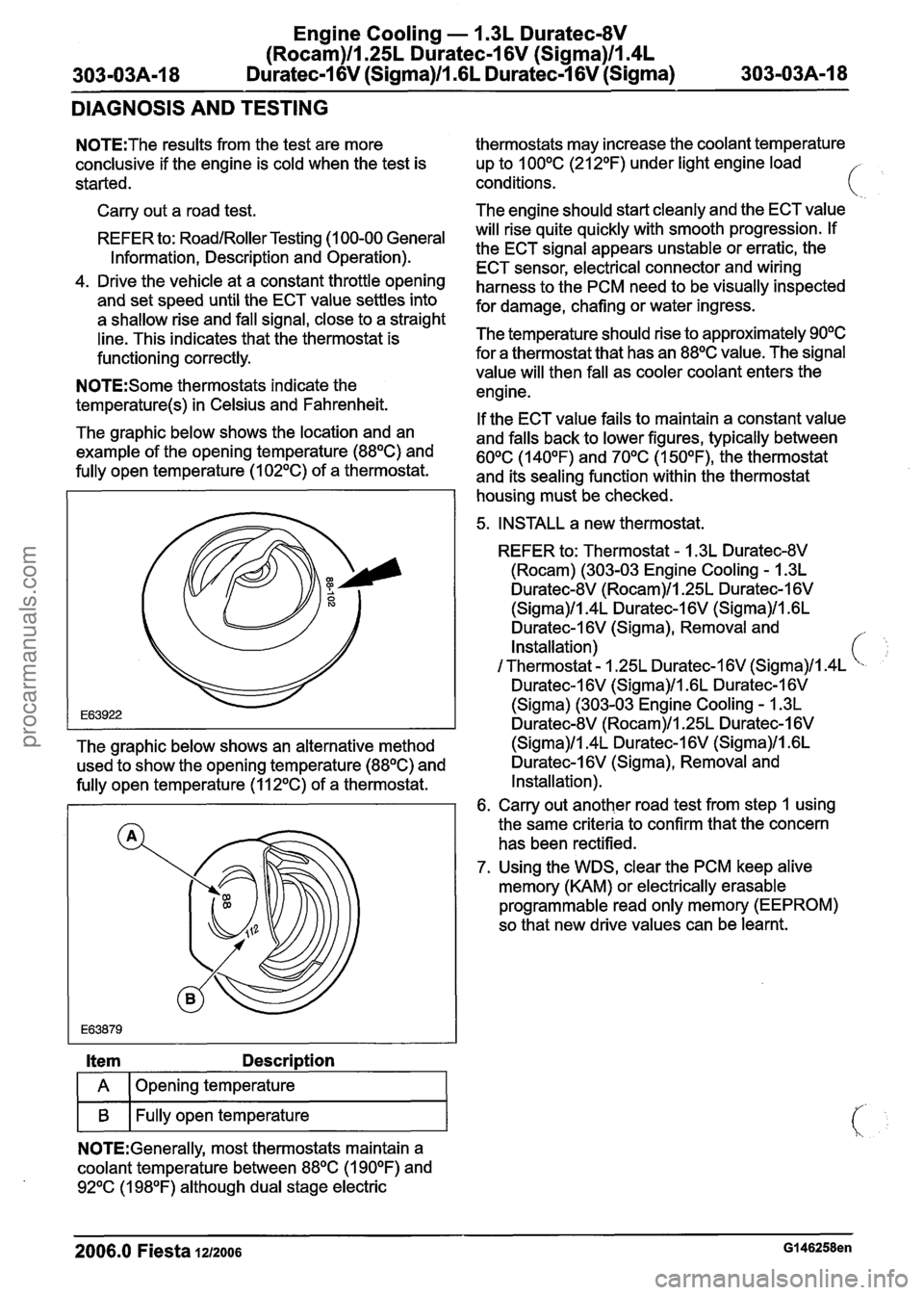
Engine Cooling - 1.3L Duratec-8V
(Rocam)ll125L Duratec-1 6V (Sigma)ll14L
3-03A-18 Duratec-I 6V (Sigma)ll.GL Duratec-1 6V (Sigma) 303-03A-18
DIAGNOSIS AND TESTING
N0TE:The results from the test are more thermostats may increase the coolant temperature
conclusive if the engine is cold when the test is up to 1
OO°C (212OF) under light engine load
started. conditions.
Carry out a road test. The
engine should start cleanly and the ECT value
REFER to:
RoadlRoller Testing (1 00-00 General
Information, Description and Operation).
4. Drive the vehicle at a constant throttle opening
and set speed until the ECT value settles into
a shallow rise and fall signal, close to a straight
line. This indicates that the thermostat is
functioning correctly.
N0TE:Some thermostats indicate the
temperature(s) in Celsius and Fahrenheit.
The graphic below shows the location and an
example of the opening temperature
(88OC) and
fully open temperature (1
02OC) of a thermostat. will
risequite quickly with smooth progression.
If
the ECT signal appears unstable or erratic, the
ECT sensor, electrical connector and wiring
harness to the PCM need to be visually inspected
for damage, chafing or water ingress.
The temperature should rise to approximately
90°C
for a thermostat that has an 88OC value. The signal
value will then fall as cooler coolant enters the
engine.
If the ECT value fails to maintain a constant value
and falls back to lower figures, typically between
60°C (140°F) and 70°C (1 50°F), the thermostat
and its sealing function within the thermostat
housing must be checked.
5. INSTALL a new thermostat.
REFER to: Thermostat
- 1.3L Duratec-8V
(Rocam) (303-03 Engine Cooling - 1.3L
Duratec-8V (Rocam)ll.25L Duratec-I 6V
(Sigma)ll.4L Duratec-I 6V (Sigma)ll .6L
Duratec-1
6V (Sigma), Removal and
Installation)
I Thermostat - 1.25L Duratec-I 6V (Sigma)ll.4L
Duratec-1 6V (Sigma)ll .6L Duratec-1 6V
(Sigma) (303-03 Engine Cooling - 1.3L
Duratec-8V (Rocam)ll.25L Duratec-I 6V
The graphic below shows an alternative method (Sigma)/l.4L Duratec-1 6V (Sigma)ll .6L
used to show the opening temperature
(88OC) and Duratec-1 6V (Sigma), Removal
and
fully open temperature (1
12OC) of a thermostat. Installation).
6. Carry out another road test from step 1 using
the same criteria to confirm that the concern
has been rectified.
7. Using the WDS, clear the PCM keep alive
memory (KAM) or electrically erasable
programmable read only memory (EEPROM)
so that new drive values can be learnt.
Item Description
I A 1 Opening temperature I
I B I Fully open temperature I
NOTE:Generally, most thermostats maintain a
coolant temperature between
88OC (1 90°F) and
92OC (1 98OF) although dual stage electric
2006.0 Fiesta 1212006 GI 46258en
procarmanuals.com
Page 784 of 1226

303-03B-14 Engine Cooling - 2.OL Duratec-HE (M14) 303-03B-14
DIAGNOSIS AND TESTING
4. Observe the cooling system pressure tester make sure the pressure test reading
is
gauge reading for approximately two minutes. repeatable
and within acceptable gauge reading
The pressure should not drop during this time. limits of
the coolant expansion tank cap.
( If the system holds Pressure, proceed to Step 5. If the pressure test gauge readings are not 7. If the system does not hold pressure, check
within the acceptable gauge reading limits,
it thoroughly for coolant leaks.
INSTALL a new coolant expansion tank cap.
5. Check the engine for coolant leaks. Drain the
cooling system, repair any coolant leaks found
and fill and bleed the cooling system as
Thermostat Test
necessaw.
REFER to: Cooling System Draining, Filling and
Bleeding (303-03 Engine Cooling
- 2.OL
Duratec-HE (M14), General Procedures).
.Recheck the system by repeating Steps 3 and
4 at least twice.
Radiator Leak Test, Removed From Vehicle
CAUTI0N:Radiator internal pressure must
not exceed
130 kpa (20 psi) or damage may
result.
Clean the radiator thoroughly before leak testing
it, to prevent contamination of the water in the test
tank. Leak test the radiator in clean water with 138
kpa (20 psi) air pressure. Check it thoroughly for
air leaks. INSTALL a new radiator if necessary.
REFER to: Radiator (303-03 Engine Cooling
- 2.OL
Duratec-HE (M14), Removal and Installation).
Coolant Expansion Tank Cap Pressure Test
A WARNING:When releasing the system
pressure, cover the expansion tank cap
with a thick cloth to prevent the possibility
of coolant scalding, Failure to follow this
instruction may result in personal injury.
1. Remove the coolant expansion tank cap.
2. Use water to clean the area of the rubber seal
and pressure relief valve. Install the pressure
tester and adapter and immerse the coolant
-
expansion tank cap in water.
N0TE:lf the plunger of the pump is depressed too
quickly, an erroneous pressure reading will result.
3. Slowly depress the plunger of the pressure test
pump until the pressure gauge reading stops
increasing, and note the highest pressure
reading obtained.
4. Release pressure by turning the pressure relief
screw counterclockwise. Tighten the pressure
relief screw and repeat step 3 at least twice to
I. Connect the WDS to the data link connector
(DLC).
2. Using the WDS datalogger function, SELECT
the following sensors (as applicable to the
application):
IAT
- intake air temperature (IAT) sensor
ECT
- engine coolant temperature (ECT) sensor
CHT
- cylinder head temperature (CHT) sensor
LOAD
- engine load
VSS
- vehicle speed sensor (VSS)
RPM
- engine speed
DSRPM
- desired engine speed
The IAT sensor output is useful if the engine being
tested is cold or after an over-night cold soak. The
ECT sensor or CHT sensor and the IAT sensor
(
should either indicate the same value or be within
1 to 2 degrees Celsius of each other.
The ECT sensor output is important to display as
it indicates the engine warm-up and opening
temperature for the thermostat. It will initially
indicate a slightly higher reading just before the
thermostat opens and then drops back before
settling to a near flat line output (see graphic
below).
Item Description 1'. .
) A 1 Thermostat opens I\
B Thermostat settles into a cyclic open and
I I closure pattern
2006.0 Fiesta 1212006 G426582en
procarmanuals.com